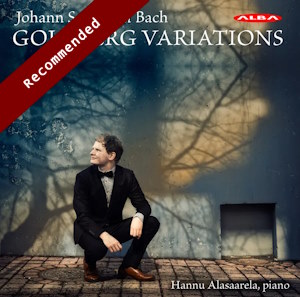
Johann Sebastian Bach (1685-1750)
Goldberg Variations, BWV988
Hannu Alasaarela (piano)
rec. 2021, Tulindberg Chamber Music Hall, Oulu Music Centre, Finland
Alba ABCD520 [79]
Only 27 years old when he recorded this, Hannu Alasaarela joins the company of prodigiously talented young pianists such as Beatrice Rana, Igor Levit, Konstantin Lifschitz – only 17! – and of course, Glenn Gould, who dared to set down their interpretation of this most challenging of baroque keyboard works at an age which raises eyebrows – and emerged triumphant. I was captivated on my first playing through and could not wait to play it again.
Alasaarela’s tempi are conventional and moderate, without the impetuosity of Víkingur Ólafsson’s new recording which divided critics and certainly evince none of the “monumental” (read “stodgy”?) quality we hear from pianists such as Rosalyn Tureck and Barenboim.
He takes the repeats, ornamenting quite freely but discreetly and subtly, and his poetic touch is immediately apparent in the opening aria, in which that ornamentation strongly suggests a soprano voice, complete with light touches of rubato. Then the brief first variation is characterised by a no-nonsense mood of “right; down to business”: urbane and straightforward – and so it proceeds; nothing is ostentatious or self-conscious in the manner which for some listeners – but by no means all, I stress – mars Ólafsson’s account. That sense of a duetting between the female and male voice is sustained throughout.
The sound is clean, clear, and bell-like – perfect, matching and reflecting the Finnish pianist’s crystalline, singing touch – a feature particularly noticeable in Variation 11, which comes across as a silvery tintinnabulation of Christmas bells (if you will excuse me a momentary flight of seasonal fancy, as I first listened to this over Christmastide…). I have never heard it played quite this way, tonally speaking, despite being acquainted with dozens of different recordings.
As ever when critiquing versions of this work, a blow-by-blow reaction to each movement would be otiose – indeed tedious – so I confine myself here to a few observations about key points. In any case, this is one of those renderings which has an organic, all-of-a-piece feeling to it. Its sheer joy and faux-casual insouciance reminds me of Glenn Gould’s playfulness without his eccentricities and it is hardly worth commenting on the technical proficiency of any of today’s foremost young pianists, such is the brilliance of their prestidigitation. Try Variation 20 on YouTube (the whole recording may be sampled there) to get a feeling for his prowess. The problem there, of course, is that sometimes that dexterity is not always allied with the requisite artistic maturity and aesthetic sensibility but that is certainly not the case with Alasaarela, who concedes finely judged hesitations and is not above indulging in the merest quirky little touches, as per above in Variation 11. That avoidance of showboating is apparent in, for example, his playing of the fourteenth variation, a toccata involving extraordinary skills in hand-crossing, jumps, runs and trills, which emerges as thrilling but still elegant and cohesive. The sombre, reflective variations, too, such as the melancholy G minor canon No. 15, are given their proper due; Alasaarela manages that suspended fifth ending so daintily, extending the pause between the last two notes daringly. He doesn’t overdue the courtly stateliness of the opening of next variation but still finds its bravura and dignity. Likewise, the rigour of Variation 18 is tempered by what comes across as an element of playfulness. He has the measure of the deceptive simplicity of No. 22, as well; everything is judiciously weighed and balanced.
While I am not dutifully plodding through every movement, no review of the Goldberg Variations would be complete without a mention of the famous “Black Pearl”, No. 25, which is here played with unsentimental clarity, even transparency, contrasting vividly with the ensuing, joyous toccata, the exuberant cascading arpeggios of No. 29 and the jolly Quodlibet before we come full circle in the simple, resigned, yet somehow deeply satisfying, repeat of the Aria, after a miraculous journey.
My MusicWeb colleague David Barker and I have praised Beatrice Rana as our ideal modern exponent of these extraordinary variations – indeed, she was among my top recommendations in my survey of thirty-four recordings of this work – but this latest release goes straight to the top of my list alongside her.
Ralph Moore
Help us financially by purchasing from



















